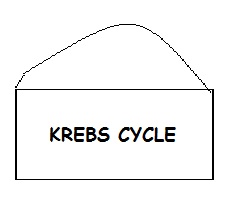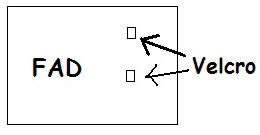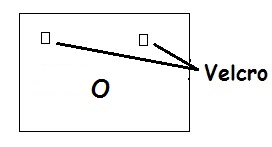|
Use of our material:
All
original materials link are created by
Kelly Riedell for students in Biology/Zoology classes
at
Brookings
High School and are licensed under a
Creative Commons Atribution-NonCommercial-ShareAlike 4.0
International License.
We have worked very hard on activities, Powerpoints/games/worksheets, etc to make
this a resource for our students. If you are using our materials, please give us
credit for our efforts by listing us as a source with links to our site. DO NOT
USE these materials for commercial purposes.
PLEASE DO NOT POST ANSWER KEYS FOR OUR
MATERIALS TO OTHER WEBSITES!
Any questions, comments, or corrections can be directed to Kelly
Riedell at

|
|
RESPIRATION THEATER
THINGS YOU WILL NEED:
Roll of Velcro with adhesive on back
yarn
hole puncher
AHEAD OF TIME
1. Copy off the
role play cards onto cardstock
OR colored paper and laminate
them.
2.
Copy the C and CO2 cards back to back
Copy the CoEnzyme A and Acetyl Co-A cards back to back
Copy the card with 4 C's and the CITRIC ACID card back to back
3. Cut apart
the e-, P, and H+ cards.
 |
4. Use a paper punch to put holes in the following
cards and attach string so card can be worn around the neck. (ATP synthase,
Matrix, Intermembrane
space, ETC, NAD+, Adenosine
P, C/CO2, Krebs cycle)
|
5. Cut small strips of Velcro at attach the hook
side to the front of to Adenosine P P card and the loop side to the back of the
P circle so it can be attached to make ATP.
Cut the "hook" strip about 1/2 the size of the "loop" side. Otherwise they
grab too much and rip off easily.6. Do the same with the NAD+ and
the H+ cards.
|
 |
 |
7. Do the same with the FAD
card to make places to
attach 2 H+ to make a FADH2 molecule.
|
 |
8. Do the same with the O
card to make places to
attach 2 H+ to make a H2O molecule. |
MINIMUM # OF CARDS YOU WILL NEED:
REQUIRED CARDS:
1 ATP synthase
2 Matrix (Can add 1 more)
2 Intermembrane space
4 Krebs cycle
1 4C/citric acid
1 citric acid/4C's
1 CoEnzyme A/Acetyl Co A
3 ETC (can use 5)
6 O |
You can add more or less of these to accommodate your class size:
6 ADP
6 NAD+
6 FAD
12 P
12 C/CO2
32 electron cards
32 H+
If you have more students you can add more ADP, NAD+, FAD, or O cards |
*******************************************************
ACT
IT OUT:ELECTRON TRANSPORT:
Students
wear appropriate name tags and line up in correct position.
ETC's and ATP synthase stand in a line ( I use 3 for Biology. 5 for AP and talk
about it)
2 Matrix people stand in front of line.(This is a busy job so you can add a 3rd
if you want)
2 Intermembrane space people stand behind line.
ADP stands near ATP synthase
NADH and FADH2 people stand near front of ETC line
ADP people stand near ATP synthase
Roles:
NADH: Passes 2 e- cards to first ETC,
gives H+ to Matrix.
FADH2 passes 2 e-
cards to SECOND ETC, gives H+ to Matrix
ETC: ALL pass e- cards along line if you use 3 ETC
pump H+ cards over
shoulder to intermembrane space;
(If you use 3 ETC-ALL pump H+; if you use 5 ETC -1st, 3rd, and 5th ETC
pump)
Last ETC passes electrons to O
O: Receives 2 e- cards from last ETC and 2 H+
from matrix to become water
MATRIX: Receives H+ from NADH & FADH2;
passes H+ to ETC; receives H+ from ATP SYNTHASE
INTERMEMBRANE SPACE: Receives H+ cards from ETC and passes H+
cards to ATP SYNTHASE
ATP SYNTHASE: receives H+ cards from intermembrane space and
passes them to matrix; holds P cards and attaches them to ADP.
Walk through everyone's job first. Compare to ETC in light dependent reactions.
Where is this happening? What are the jobs? Where do electrons
come from? Where is ATP and WATER made?
Where does H+ build up? How many H+
are pumped from NADH? From FADH2?
Where
does NAD+ go once it has dropped its
electrons?
Then let them do it on their own. Then do it without you telling them what to
do.
Then trade jobs with someone and do it again.
LATER CAN ADD IN:
GLYCOLYSIS,
ACETYL CO-A charging OR
KREBS CYCLE IF DESIRED
****************************************************************
GLYCOLYSIS
6 C people
each hold 2 e- cards and link
arms to represent a 6 carbon glucose
GLYCOLYSIS: receives a P from 2 ATP's; breaks 6 C's into TWO 3-C molecules
3 C group (pyruvate): gives e- cards to NAD+
CYTOPLASM: Gives NAD+ a H+
2 NAD+ people: Each receives 2e- from 3C
group and H+ from CYTOPLASM
GLYCOLYSIS:Gives a P each to 4 ADP
ADP: receives a P from glycolysis
3 C group (pyruvate): goes on to ACETYL CO-A charging
****************************************************************
ACETYL CO-A Charging:
3 C people
each hold 2 e- cards and link
arms to represent a 3 carbon pyruvate
Last C in line is released and gives its e- cards to NAD+ and flips their
card to show CO2 side.
MATRIX: Gives H+ to NAD+
Remaining 2 C's join with COENZYME A and COENZYME A flips their
card over to show ACETYL CO-A side
ACETYL CO-A carries C's to KREBS CYCLE; flips their card back to COENZYME-A side and returns to ACETYL CO-A
CHARGING to find another 3 C pyruvate
***************************************************************
KREBS
CYCLE:
4 Krebs people stand in ring (Krebs #1 person has 4 /citric acid card)
Krebs people move in a circle when cycling.
Krebs #1 (4C/citric acid) person: receives 2C's from Acetyl Co-A and
welcomes them into circle
Breaks off a C from and receives e- cards from C and
passes them to NAD+
Krebs #2 person: Breaks off one of C's that entered, takes their 2e- cards and passes them to
NAD+
MATRIX: Gives H+ to NAD+
Krebs #3 person: Breaks off last of C's that entered, takes their 2e- cards and passes them to FAD
MATRIX: Gives H+ to FAD
Krebs #4 gives P to ADP to make ATP
C: passes E- cards to Krebs cycle, flips card to CO2 side,
and leaves the circle
*****************************************************************************
Bioteacher
help Biology
other units APBIOteacher
help Riedell
Science Home APBIO
other units Zoology
other units



